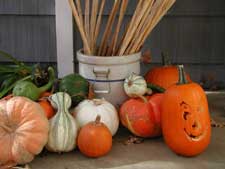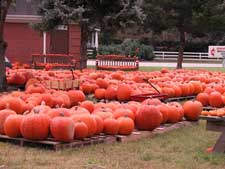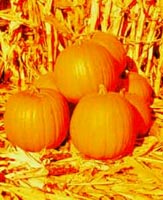Resource Library
Plant of the Week: Pumpkin (Jack O' Lantern)
The University of Arkansas System Division of Agriculture does not promote, support or recommend plants featured in "Plant of the Week." Please consult your local Extension office for plants suitable for your region.
Plant of the Week
Pumpkin, Jack O' Lantern
Latin: Cucurbita pepo

The pumpkin is as American as apple pie, yet its current status is a result of our diverse cultural heritage.
History of pumpkins
The word pumpkin is derived from the middle English word "pumpion" which described a type of Old World melon. The pumpkins and squashes are thought to have originated in Central America and Mexico. They spread as Native Americans adopted them as a staple food over 9,000 years ago.
Among the New England tribes these plants were described as "askutasquash." The Puritans of New England adopted "pumpion" for the large, orange-fruited vines and "squash" for all of the smaller-fruited edible sorts.

What are pumpkins related to?
Botanically speaking, pumpkins and squashes are kissing cousins belonging to the cucumber family. They are so closely related that pumpkins and some squashes will readily cross pollinate one another.
If a non-pumpkin type pollinates a pumpkin flower, the resultant fruit will look like a normal pumpkin, but if seeds are saved and planted the next season, the fruit of the hybrid plant will be mongrelized.
The acceptance of pumpkins by early colonists was not immediate.
In fact, it took a good long New England winter to convince them that they were indeed tasty and nutritious. One of the earliest methods of preparing pumpkins was to cut a hole in the top, scoop out the seeds, and then fill the cavity with apples, molasses, spices and milk. The top was put back on and then the pumpkin was baked in a bed of coals.
By the late 1700's, the standard method of preparing pumpkin, other than pumpkin bread, had become our standard pumpkin pie, which included eggs, molasses, allspice and ginger baked in a tart shell.
Where did jack o' lanterns come from?

The tradition of the jack o' lantern is interwoven with the traditions of the ancient Celts who celebrated a ceremony that apparently was part harvest ceremony and partly a ceremony to appease the spirits of the dead. This ritual included carrying lighted embers from ceremonial bonfires in carved out turnips -- a readily available ember-holder. Faces were carved on these turnips to scare off the spirits of the dead that came back to visit earth -- often in the form of black cats. In the 1750s, the old Irish folktale was written down, but changed to include a night watchman named Jack.
The Irish potato famine a century later resulted in the immigration of over 600,000 Irish men and women to the United States. Finding few big turnips to carve, the pumpkin was adopted for Jack's lantern for the Christian All Hallows Eve festival. That holiday evolved into our nonsecular Halloween.
Want to grow pumpkins? First assess your goal.
If the goal is to grow pumpkins for pies, one of the small fruited pie types such as Small Sugar or Jack-Be-Little are best. But if the goal is to grow a good carving pumpkin, say something in the 20 to 30 pound range, selections such as the old Connecticut Field or Jack o' Lantern are hard to beat.
If the goal is to grow giant pumpkins for county bragging rights, Dill's Atlantic Giant, which occasionally will top 600 pounds, is for you. Pumpkins require 100 to 115 days to mature fruit and are usually planted after the soil warms in the spring from mid May until late June for jack-o-lanterns.
For more information on growing pumpkins, download the Home Gardening Series: Pumpkins